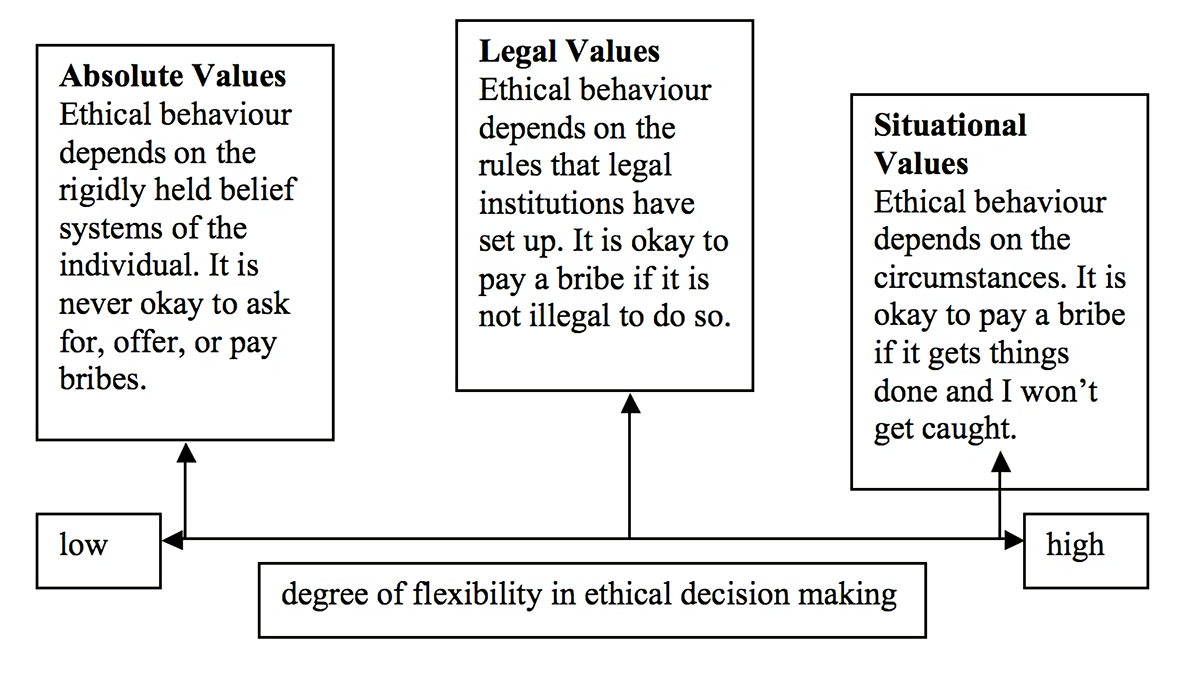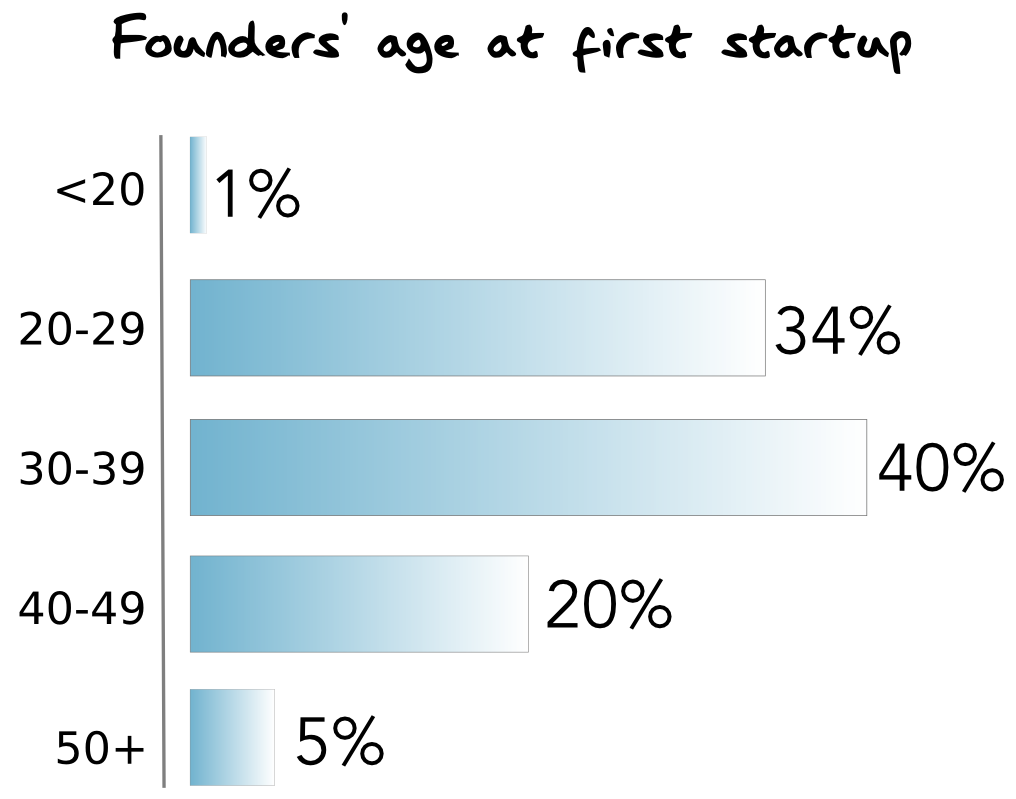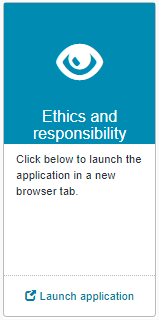Imagine the following scenario: You are in the process of opening a restaurant and are meeting with the health inspector. The inspector examines your restaurant and recognizes that some things should be improved. The inspector, however, is prepared to give you a clean report, but says that it will cost you $5,000 in cash, which you must provide immediately. Otherwise, your restaurant opening will be delayed by a month or more. What do you do?
Once your restaurant is open, you get several requests every day for a donation of gift vouchers that will go towards a fundraiser for juvenile diabetes, a new school gym, a local theatre production, a food bank program, or other good cause. What do you do?
The first scenario above involves ethics—yours and the health inspector's. The second scenario involves social responsibility—community payback. This learning activity examines both. As the learning activity develops, you will be asked to consider how ethical and socially responsible you would and/or should be as an entrepreneur. You will also compare the difficulties of being a young entrepreneur with the challenges older entrepreneurs face. Starting a business is exciting yet requires consideration of both the potential successes and challenges. For example, governments and industries expect businesses to work in certain ways. There are financial responsibilities as well as obligations to employees. Thinking about potential challenges will support success.
Ethics
Ethics are the standards of right and wrong that we set for ourselves, or that are set for us by others (our organization, our legal system, our parents or guardians, and so on). Your ethics depend on your values. Values are concepts such as fairness, justice, good citizenship, and caring for others. Some people, for example, consider extreme patriotism (devotion to one’s country) to be a good thing, while others consider it to be bad. Canadian values include freedom, democracy, the rule of law, and respect for human rights. What you value is a matter of personal choice. Have you thought about your values?
Think
Take a few minutes to reflect upon your values and why they are important to you.
Ethical policies and the degree of flexibility in ethical decision making
Most organizations have policies regarding ethical behaviour in the workplace that describe proper ethical decision making. Your venture, for example, should have ethical policies that are not only written down, but are practiced and enforced, both in word and action. Certain issues are too important to be left as a matter of personal choice. In most cases, if your organization does not have a policy covering these issues, the law certainly does.
Examine the following diagram and observe how the degree in which there is flexibility in ethical decision making depends on the nature of the values that individuals hold. The diagram is using the ethical issue of bribery to demonstrate this.

To summarize, the diagram exhibits that:
- people who hold absolute values (in this case, believe that it is never okay to ask for, offer, or pay bribes) have a low degree of flexibility in ethical decision making;
- people who hold legal values (in this case, believe that it is okay to pay a bribe if it is not illegal to do so) have a moderate degree of flexibility in ethical decision making;
- people who hold situational values (in this case, believe that it is okay to pay a bribe if it gets things done and I won’t get caught) have a high degree of flexibility in ethical decision making.
Some important ethical issues are harassment and discrimination, bribery, payment of invoices, consumer fraud, and concern for the environment.
Harassment and discrimination
According to the Ontario Human Rights Code (OHRC), harassment means engaging in a course of vexatious comment or conduct that is known or ought reasonably to be known to be unwelcome.
Harassment is a course of conduct, which means it must occur more than once. It is vexatious, which means that it upsets or bothers others. It can be either verbal or part of an action. Most people should know when their behaviour is inappropriate and unwelcome, but harassment is easier to prove when the victim has evidence (letter, email, witness, and so on) that the harassing behaviour has been identified as inappropriate and unwelcome.
Harassment can occur because of race, ethnicity, origin, citizenship, religious belief, age, record of offences, marital status, sexual orientation, family status, or disability. As a business owner, you must be conscious of how harassment can occur and what you need to do to prevent it or handle it appropriately if it is reported.
According to the OHRC, discrimination doesn’t have a prescribed definition, but could include:
- not individually assessing the unique merits, capacities and circumstances of a person;
- making stereotypical assumptions based on a person’s presumed traits;
- having the impact of excluding persons, denying benefits or imposing burdens.
Grounds for discrimination include many factors but the most common are age, race, ethnicity, sexual orientation, religion, disability, and gender identity.
Lucy Farias v. David Chuang, Queenstate Dental Care
Lucy Farias worked as a dental assistant at Queenstate Dental Care, a sole proprietorship run by the respondent dentist, David Chuang. The Tribunal found that Dr. Chuang made advances towards Ms. Farias, that she eventually told him were unwelcome, and that he continued his advances after that time, forcing Ms. Farias to quit. It held that Dr. Chuang violated sections 5(1), 7(2) and 7(3)(a) of the Code by continuing to make overtures towards Ms. Farias after she told him to stop. It also held that Dr. Chuang took reprisal action against Ms. Farias contrary to sections 7(3)(b) and 8 of the Code, for example by becoming unduly harsh and arbitrary in his criticisms of her work, by withholding her Record of Employment and termination pay, and by billing her for dental services he had promised would be free.
The Tribunal awarded $32,000 for general damages and mental anguish and $4,354 for 14 weeks’ wages, and ordered Dr. Chuang to attend anti-discrimination training.
Source: Ontario Human Rights Commission Harassment Case
Bribery

Bribery is the offering of a consideration (such as money, property, advancement, or status) for special treatment. It consists of two types: active bribery (offering or providing a bribe) and passive bribery (demanding or accepting a bribe). According to the Criminal Code of Canada, bribery is illegal when it involves a domestic public official, such as a police officer or government employee. The behaviour of the health inspector in the example in the introduction of this learning activity was illegal, and if caught and convicted, the health inspector would certainly be fired and might even spend time in jail. Bribery is also illegal when it involves a foreign public official, but only as active bribery. Any other type of bribery (for example, a supplier bribing a purchasing agent in a private sector organization) is not a criminal act, but is considered unethical by most Canadian organizations.
Payment of invoices
You should always pay your invoices on time. It is unethical to keep your suppliers waiting for payment, as they need the money from the goods they sold you in order to make more products and continue to make money.
When payment is due, however, depends on the due date printed on the invoice. It is very rare for a supplier to demand payment immediately after you receive the shipment, or collect the amount owing when the merchandise is shipped (known as cash on delivery, or COD). Almost all suppliers will allow a business to take some time to pay its bills. This extra time is included in the terms of payment. Terms are often expressed in two parts: the discount section and the date due section.
You can arrange reasonable terms for payment of your bills, but if you find yourself getting behind in your payments, you shouldn’t ignore it. The problem will not go away by itself. To behave ethically, you should do two things:
- Contact your suppliers and tell them you are having difficulty making the payment, but that you would like to work out a way to pay off your debts with them. The business will likely be impressed that you are open about this and willing to work out a payment schedule with you that will help.
- Stop buying! Until all your invoices are paid and you are in better financial shape, sell what you have, at a discount if you need to. Get your money out of your inventory before you buy more. It is unethical (almost fraud) to buy merchandise you are not sure you can pay for.

The following is an example of an invoice’s payment terms.
Perfect Presents, a giftware store, receives a $7,000 shipment of candles they ordered from the Crafty Candle Company. The terms of the invoice are 3/20, n/60.
- 3/20 means that Perfect Presents can save 3% of the total if the invoice is paid within 20 days.
- n/60 means that the invoice must be paid in full (no discount) by the end of 60 days.
After 60 days of non-payment, Perfect Presents will receive a notation on their credit record that will make it more difficult for them to obtain credit in the future. They could also incur additional interest charges on the overdue amount. It is unethical not to pay a bill on time.
Consumer fraud
Perhaps one of the most common forms of unethical behaviour by entrepreneurs is consumer fraud. It is often not totally intentional, but is considered a stretching of the ethical rules in order to make a sale. The following are some of the unethical practices some businesses use to cheat (or rip off, con, scam, swindle, deceive, hoax, fool, or take advantage of) their customers.
A very low advertised price brings customers into a store, but the salesperson then tries to sell the customer a much more expensive product.
Products are described as better than they really are or on sale when they are not.
Selling products that don’t work.
Offering a once-in-a-lifetime deal or putting other pressure on buyers to encourage them to buy without the time to think things through.
Taking advantage of an area’s poverty and desperation to hire a cheap labour force.
Complete the following “Ethical issues (Opens in new window)” worksheet in order to identify the ethical issues in each situation.
Concern for the environment
Notebook
In your notebook, answer the following questions. Be prepared to share your responses with your class and/or teacher.
- Why is it important for an entrepreneur to be concerned about the environment? Explain.
- Provide an example of an unethical business activity, which demonstrates a disregard for the environment. In your example, make sure to describe the business (what it sells or does) and the unethical business activity. This example may be fictitious or real. If it is real, please make sure to reference your source(s).
- How could you convert the unethical business activity, previously mentioned, to one that places emphasis and care for the environment? Explain.
- How would you ensure that ethical practices, with regard to the environment, would be followed in your venture?
Join the discussion
Once you have completed the previous task, share your response to the following in the discussion.
- Provide an example of an unethical business activity, which demonstrates a disregard for the environment. In your example, make sure to describe the business (what is sells or does) and the unethical business activity. This example may be fictitious or real. If it is real, please make sure to reference your source(s).
You are now required to review the examples of your classmates and provide a solution as to how the unethical business activity could be converted to one that places emphasis and regard to the environment. Make sure to provide a solution to two of the examples of your classmates. Consider the tips for participating in online discussions.
Ethical business is profitable business
Ethical business practices are hardly noticed, but unethical ones often cause damage to a business reputation. Customers like to deal with businesses and brands they can trust, and many firms spend millions of dollars to build that trust. Few companies will throw away a good reputation for a little extra profit.
Ethics are always good for business. The debate is often whether businesses are ethical because they want to be or because it is more profitable for them if they are.
Think
Take a few minutes to reflect on the following statement: The debate is often whether businesses are ethical because they want to be or because it is more profitable for them if they are. What are your thoughts?
Social responsibility and your venture

All businesses are members of their community. Each one is a corporate citizen. The term corporate citizen applies to all organizations that operate within a community. Even a small corner store can be a good or bad “corporate citizen”—a generic term for any organization’s interpretation of its ethical responsibilities to its neighbours, its community, or even the rest of the world. Events in the community, such as economic hardship or increased tourism, affect an organization’s success. In turn, an organization’s actions affect the well-being of a community.
An organization should act ethically, even without specific laws to force ethical behaviour. It should also be socially responsible by helping to make the community a better place. Social responsibility is an ethical or ideological theory that a government, corporation, organization, or individual has a responsibility to benefit society. The term for an organization’s social responsibility is corporate social responsibility (CSR).

An organization has an impact on a variety of people who have an interest in the organization. These people are called stakeholders. A stakeholder is a person or organization affected, either monetarily or otherwise, by policies set or actions taken by industries, businesses, or institutions. An organization’s stakeholders will include its employees, its customers, its suppliers, its debt holders (such as banks or trust companies), local community groups, environmental organizations, government agencies, shareholders, and charitable organizations. If the corporation is not responsible in certain areas, many others are affected.
Organizations take different approaches to social responsibility. Some, such as Tim Hortons, are leaders in the area, organizing a variety of community children’s programs. Others simply do the minimum required by law to avoid negative publicity and keep a low profile in their community.

As an entrepreneur, your social responsibility efforts include an ethical issue. Before you continue in this course, stop and reflect upon the following questions: What is your motivation for taking a leadership role in providing good works in your community? Are you interested in improving the standard of living for employees to make them stay? Do you institute corporate responsibility programs to garner positive publicity and improve your venture’s reputation? Are you truly interested in giving back to the community that supports your business? Do the reasons matter, as long as you are making a positive contribution in the community?
Notebook
In your notebook, answer the following reflection questions.
- What is your motivation for taking a leadership role in providing good works in your community?
- Are you interested in improving the standard of living for employees to make them stay?
- Do you institute corporate responsibility programs to garner positive publicity and improve your venture’s reputation?
- Are you truly interested in giving back to the community that supports your business?
- Do the reasons matter, as long as you are making a positive contribution in the community?
If the community benefits, you benefit as well. The reasons to get involved in social responsibility are complex and unique to each entrepreneurial person involved.
Let us now examine how to assess the social responsibility of a venture.
You can assess your venture’s social responsibility by examining the following four areas:
Try it!
Put the following four types of social responsibility listed in the order in which companies should be compliant.
Select your answers, then press on the Submit button to check if you are right!
Bear in mind, you can use these criteria to evaluate your venture’s degree of social responsibility and take steps to incorporate these criteria into your venture plan.
Let us examine Tim Hortons further. Many consider Tim Hortons to be an example of a company that is socially responsible. Here are some of the ways it demonstrates its social responsibility.
-
Supporting local community initiatives include:
- Tim Horton Children’s Foundation- camp programs for children from disadvantaged circumstances
- Timbits Minor Sports Program- sponsorship for minor sports programs
- Smile Cookie- to raise funds for local charities
- Coffee partnerships- improving the life of coffee farmers and their communities by helping them increase their productivity and quality of beans in a sustainable fashion.
- National sponsorships
-
Sustainability and Responsibility and making a difference for:
- individuals- providing customers with balanced food choices and a welcoming experience
- communities- charitable initiatives in the community
- the planet- environmental stewardship
Discover more
Research “Tim Hortons controversy”. Has the company always behaved ethically?
Portfolio
Based on the four areas (legal, economic, ethical, and leadership) of responsibility, create a checklist that could be used to evaluate any organization’s social responsibility.
Make sure that the checklist:
- includes at least 10 points
- includes points from each of the areas
- is clear and easy to understand and use
- is professional in appearance
- is free from spelling and grammatical errors
As a reminder, to assist in the organization of the portfolio when you are required to complete a task, be sure to include the learning activity title and number along with completed task.
Submit your portfolio item(s) by pressing the “Go To Portfolio” button.
Examine the following document “Sprinkles Bakery and Social Responsibility” (Opens in new window) to learn some new information for our fictional business, Sprinkles Bakery.
Use the checklist that you created to assess the social responsibility of “Sprinkles Bakery”. Based on your checklist, would you consider “Sprinkles Bakery” to be a socially responsible organization?
Join the discussion
Let’s use peer evaluation to improve your checklist.
Instructions:
- Post your checklist.
- Choose two classmates' checklists. Review the checklists and provide feedback. In your feedback, make sure to include at least one area of strength (what your peer has done well) and one area of improvement (an aspect of the work that your peer could improve). To assist, refer to the criteria that was given for the creation of the checklist.
Comments should be positive and supportive. Avoid making judgments and make sure to review your comments before posting. Consider the tips for participating in online discussions.
You’ve learned about ethics and social responsibility in entrepreneurial business. Next, you will explore a game in which you will be presented with a series of ethical and social responsibility choices. Feel free to review the scenario more than once to explore the variety of outcomes that can result from your good or bad decisions.
Entrepreneurs at any age
Entrepreneurs’ lives can be full of excitement and adventure, but a new venture also carries extra responsibility, stress, risks, and pressure. How do entrepreneurs of various ages handle this role? Is one group more suited to this lifestyle than another?
Statistics on age groups
The following table provides information on the gender, minority status, and managerial experience of entrepreneurs (under 39) and older entrepreneurs (over 39). According to Statistic Canada, “Visible minority refers to whether a person belongs to a visible minority group as defined by the Employment Equity Act. The Employment Equity Act defines visible minorities as “persons, other than Aboriginal peoples, who are non-Caucasian in race or non-white in colour”. When you explore the table, you will understand that more young women than older women start their own businesses. The chart also shows that young entrepreneurs have more formal education but less management experience than older entrepreneurs.
Examine the following table. What do you notice? What conclusions can you make?
| Characteristics | Younger entrepreneurs | Older entrepreneurs |
|---|---|---|
| Gender |
|
|
| Minority status |
|
|
Source: Statistics Canada https://www.ic.gc.ca/eic/site/061.nsf/eng/h_rd01200.html
Challenges for entrepreneurs of various ages
The statistics provide an overview, but it is important to explore beyond the numbers to fully understand the challenges and opportunities facing entrepreneurs of various ages.
Notebook
In your notebook, create a table similar to the following one that you can use to gather information as you review the content that follows.
| Age group | Opportunities (Advantages) | Challenges (Disadvantages) |
How can challenges be overcome? (based on the content and in your opinion) |
|---|---|---|---|
| Under 20 | |||
| 20 to 29 | |||
| 30 to 50 | |||
| Over 50 |
Under 20

More and more people under the age of 20 are being exposed to the idea of entrepreneurship as a career. Elementary schools across Canada are introducing programs such as Junior Achievement and The Learning Partnership’s Entrepreneurial Adventure that teach students as young as 10 what it takes to be an entrepreneur. Many high schools offer courses in entrepreneurship, such as the one you are taking. Some students use this learning as a stepping stone to actually launching a venture. Others head towards entrepreneurship by following their dreams and passions.
One advantage for young people is that they do not have the inhibitions or responsibilities of older adults. They often do not have financial or family obligations.
The biggest challenge facing entrepreneurs under the age of 20 is being able to get the funding they need to start their venture and operate it in the early stages. The difficulty of getting financing may also be coupled with a perceived lack of experience and knowledge.
Ages 20 to 29
Many people between the ages of 20 and 29 choose entrepreneurship as a career because they are interested in the increased freedom that comes with being your own boss. Many have observed their parents or caregivers work long and hard for someone else and they want more control over their destiny. Others simply have the necessary energy, initiative, and courage and are confident they can create a successful venture.

The BDC (Business Development Bank of Canada)’s Young Entrepreneur is one of many programs designed and targeted to assist and recognize young entrepreneurs. There are numerous websites, government programs, and associations set up to encourage and support young entrepreneurs in this age group. These young entrepreneurs are often driven to succeed and are technology-oriented. These characteristics give them an advantage in the marketplace. At the same time, they face challenges, including inexperience, lack of credit history, student loan debt, and lack of personal resources. For this reason, governments at all levels offer financing and support to young entrepreneurs for start-up ventures. Many of these programs include mentoring, mandatory attendance at workshops, written business plans, and accountability.
Young entrepreneurs often face rejection many times before they achieve success. The ability to be persistent is one of the key factors leading to success. This persistence is not too different from the persistence required to complete a distance education course. You have to motivate yourself to do the work, conduct research, and meet your deadlines in order to be successful.
Ages 30 to 50

Entrepreneurs between 30 and 50 represent the largest group of entrepreneurs in Canada. One of the challenges many encounter is that being a successful entrepreneur requires a lot of hard work, both on the business venture itself and also in establishing the business relationships that will allow the venture to grow. This can delay or undermine of achieving the work/life balance many of these entrepreneurs crave. However, working long and hard at something you are passionate about is often more satisfying than working long and hard for someone else. Entrepreneurs in this age group bring a wide range of experiences with them. Often, their idea or opportunity was identified during their working career.
Over 50
Entrepreneurs aged 50 years and older make up the fastest-growing segment of entrepreneurs in Canada. This group is made up of baby boomers and Gen Xers between the ages of 50 and 65. For many, self-employment is a viable and attractive option for a second career after retirement (a career and a pension). These entrepreneurs are sometimes referred to as “seniorpreneurs”. These older entrepreneurs are often not yet ready to retire. Some are concerned about boredom during retirement, while others seek a supplemental income to support their lifestyle. Others want to leave a legacy for their family. There are many different reasons why people in this age group become entrepreneurs.

Despite the fact that they are growing in number, this group is largely ignored by policy makers. As a result, there are few programs directed at supporting them and helping them with their specific issues.
Entrepreneurs in the 50 and over age group bring a great deal to a venture. Many will bring managerial experience, wisdom, a large network, credibility, and sometimes their own financial resources. Similar to entrepreneurs under 30, the older entrepreneurs often have difficulty securing funding for their enterprise. Financial institutions do not like taking the risk that there will not be enough time for loans to be paid back.
Entrepreneurs at different ages and stages face unique challenges and opportunities. Young entrepreneurs have energy, ambition, and access to many support programs. However, they may find it hard to get funding and establish a reputation in the field. Older entrepreneurs have more experience and credibility but often get less outside support when starting their own businesses.
Exploring Canadian entrepreneurs and age (advantages and disadvantages)
If you are thinking about starting your own venture, it’s useful to know what obstacles you may face and what strengths you can rely on.
Portfolio
Conduct research on one of the following Canadian entrepreneurs:
- Heather Reisman
- Kane Wav
- Rupi Kaur
- Jennifer Corriero
In your portfolio, create a table similar to the following one and complete it with the information you have investigated.
| Entrepreneur’s Name | ||
|---|---|---|
| Questions | Responses | Sources used/cited |
| Name of venture | ||
| Age of entrepreneur when venture was started. | ||
|
Opportunities entrepreneur experienced. In what ways was being this age an advantage? |
||
|
Challenges entrepreneur experienced. In what ways was being this age a disadvantage? |
||
Review the following clip of Rupi Kaur discussing how her childhood experiences and passion for poetry inspired her to create a business. What sacrifices did Kaur make to get her work published? Which entrepreneurial characteristics do you think Kaur demonstrates in her interview?
Explore this!
In the following video, Rupi Kaur discusses her history with poetry and how she found success as an entrepreneur.
Notebook
Trend analysis
Use your notebook to respond to the following:
The histogram indicates the percentage of entrepreneur and the age group for their first startup. Why do you think this might be the trend? When might you wish to plan your own venture? Give some specific reasons you might have as to when you might wish to plan your own venture. Hint: examine the trend analysis and the opportunities and challenges of age groups.

In this learning activity, you explored how ethical and socially responsible you should be as an entrepreneur. You also compared the challenges and opportunities facing entrepreneurs from different age groups. Building and running a business at any age means facing all kinds of ethical issues related to basic fairness, personnel and customer relationships, plus environmental, cultural, social, and other challenges. There may not always be clear-cut answers, but being ethical and socially responsible can be good business.
Assessment Opportunity
Individual or Group Assessment Opportunity
In this learning activity, you learned about ethics and social responsibility. In this assessment, you will explore how some entrepreneurs identify problems and issues within their communities and build businesses (both profit and non-profit) that address the problems/issues.
Communities are faced with a range of complex and challenging issues (i.e., poverty, homelessness, gender inequality, discrimination, etc.). These issues require creative and motivated entrepreneurs to develop innovative solutions that inspire change.
Individually or in groups, you will pick an entrepreneur who has built a business to address problems and/or issues in communities. Then, you will create a slide presentation that includes the following:
- Who is the entrepreneur, or who are the entrepreneurs? Include background information.
- What entrepreneurial skills and characteristics make the entrepreneur(s) successful?
- What have they done to make them a community improvement entrepreneur?
- What challenges have they faced and how did they overcome them?
- How have they impacted the community?
- Is there any other important information to include?
- Pictures, videos that relate to the entrepreneur.
- Sources cited (APA Style format).
Before you or your group begins researching and creating the slide presentation, it is important that you or your group select the top two entrepreneurs you wish to research. Make sure to provide your teacher with both the name(s) as well as a brief description of their venture. The teacher will then give the group approval to start the task. The purpose of this is to avoid duplication of entrepreneurs.
When completed, the group slide presentations will be shared with the teacher.
Design and layout checklist:
- Is our presentation free of spelling and grammatical errors?
- Are the images and videos used relevant to the topic, text, and properly referenced?
- Is there enough white space among text, images, and videos?
- Is the font consistent, appropriate, and readable, with no more than two or three sizes throughout?
- Is the colour of background and text consistent?
- Have we limited the words on each slide?



